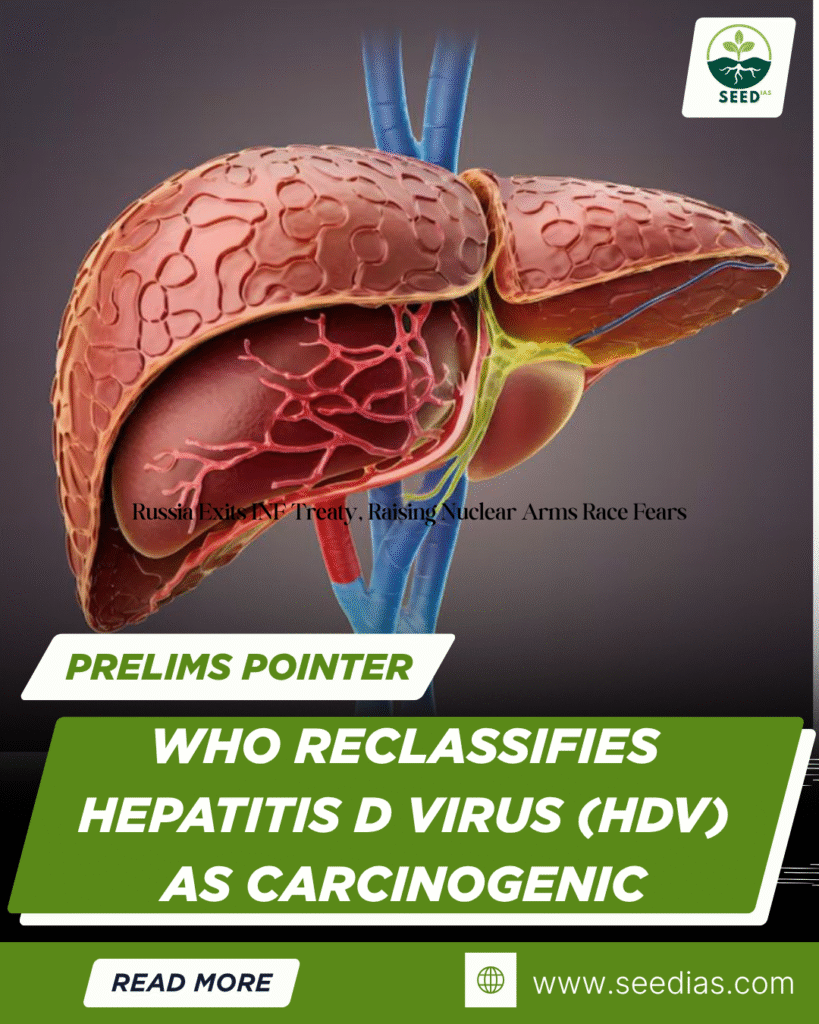Why in NEWS
The World Health Organization (WHO) has reclassified the Hepatitis D Virus (HDV) as carcinogenic due to its strong association with an increased risk of liver cirrhosis and hepatocellular carcinoma, particularly in people with Hepatitis B Virus (HBV) infection.
Key Terms / Concepts
| Term / Concept | Explanation |
|---|---|
| Hepatitis | Inflammation of the liver caused by viral infections, autoimmune disorders, alcohol, drugs, or toxins; can be acute or chronic. |
| Hepatotropic Viruses | Viruses that primarily infect the liver, such as Hepatitis A, B, C, D, and E. |
| Hepatitis D Virus (HDV) | A defective virus that requires HBV for infection and replication, causing severe liver disease. |
| Co-infection | Simultaneous infection with HBV and HDV. |
| Superinfection | Infection with HDV in someone already chronically infected with HBV. |
| Hepatocellular Carcinoma | The most common type of primary liver cancer. |
Details
| Aspect | Information |
|---|---|
| Nature of Disease | Hepatitis can be asymptomatic in early stages, later causing fever, fatigue, jaundice, dark urine, pale stools, and joint pain. Chronic cases may progress to fibrosis, cirrhosis, or liver cancer. |
| Causes | Hepatotropic viruses (A–E), other viruses (Varicella, SARS-CoV-2), alcohol, drugs, autoimmune disorders, fatty liver. |
| Global Burden (2022) | WHO: 254 million hepatitis B cases, 50 million hepatitis C cases, 1.3 million deaths; half of chronic cases occur in ages 30–54. |
| HDV Risk | Increases chances of cirrhosis and hepatocellular carcinoma by 2–6 times compared to HBV alone. |
| Prevalence in India | Likely underreported; higher in intravenous drug users and chronic HBV patients. |
| Diagnosis | HDV-RNA test. |
| Treatment | Limited options; bulevirtide shows promise. |
| Prevention | HBV vaccination (about 50% coverage in India), safe blood transfusions, needle safety, safe sex practices, high-risk group screening. |

Key Initiatives
| Initiative | Objective |
|---|---|
| WHO’s 2022–2030 Global Strategy | Reduce new hepatitis infections by 90% and deaths by 65% from 2015 levels; target 520,000 cases and 450,000 deaths annually by 2030. |
| National Viral Hepatitis Control Program (India) | Eliminate viral hepatitis by 2030. |
| Universal Immunization Programme (UIP) | Provide free HBV vaccination nationwide. |
| World Hepatitis Day | Annual awareness campaign on July 28. |
In a nutshell
HDV is a dangerous companion to HBV, greatly increasing liver cancer risk. Prevention is primarily through HBV vaccination and safe medical practices.
Memory Code: “B-H-D”
B for HBV vaccination
H for High-risk screening
D for Diagnosis & early treatment.
Prelims Practice Questions
- Which of the following statements about Hepatitis D Virus (HDV) is correct?
A. It can infect humans without the presence of HBV.
B. It increases the risk of hepatocellular carcinoma compared to HBV alone.
C. It is transmitted only through contaminated water.
D. It is caused by a bacterium. - Which of the following is NOT a prevention method for HDV infection?
A. Hepatitis B vaccination
B. Safe blood transfusions
C. Needle safety practices
D. Antibiotic prophylaxis - According to WHO’s 2022–2030 Global Strategy, the target reduction in new hepatitis infections from 2015 levels is:
A. 50%
B. 65%
C. 75%
D. 90%
Prelims Answers & Explanations
| Q.No | Answer | Explanation |
|---|---|---|
| 1 | B | HDV is a defective virus requiring HBV for replication; co-infection increases cancer risk. |
| 2 | D | Antibiotics do not prevent viral hepatitis; prevention is via HBV vaccination and safe medical practices. |
| 3 | D | WHO aims to reduce new infections by 90% and deaths by 65% by 2030. |
















